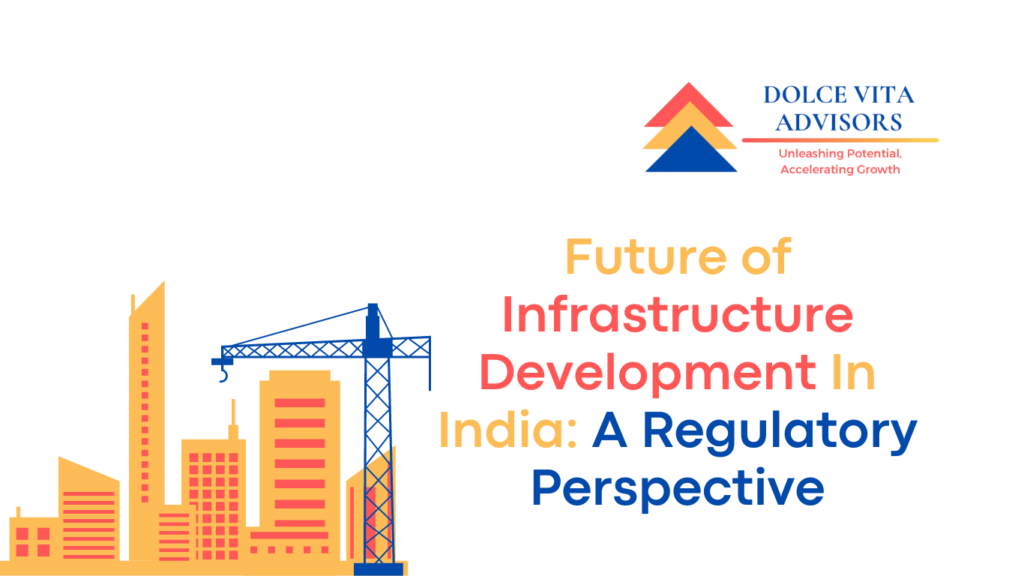
Insights by: Sumit Kochar & Neha Jha
India is targeting a GDP of US$5 trillion by 2027 and US$7 trillion by 2030, focusing on infrastructure growth to support this ambitious goal. The government has allocated INR 11.11 trillion (US$155.5 billion) for infrastructure in FY 2024-25, with a total investment of INR 143 trillion (US$1.72 trillion) planned between 2024 and 2030. The government’s infrastructure strategy includes programs to enhance connectivity, logistics capacity, and other key areas, with a focus on attracting private sector investment.
Infrastructure development in India is not limited to physical infrastructure, but also includes digital and social infrastructure. The government has introduced various schemes and policies, such as the National Infrastructure Pipeline (“NIP”) and the PM GatiShakti Master Plan, to address India’s infrastructure needs.The NIP, introduced in 2019, emphasizes social and infrastructure projects, including energy, roads, railways, and urban development projects worth INR 102 lakh Crore. The Centre and States have nearly equal contribution (39% and 40%), while the private sector has a 21% share. The PM GatiShakti Master Plan aims to improve India’s logistics network. The PM GatiShakti Master Plan integrates infrastructure schemes like Bharatmala, Sagarmala, and UDAN under a digital platform, providing a comprehensive database of trunk and utility infrastructure, ongoing, and future projects from both central and state governments. Integrated with the GIS-enabled PM Gatishakti platform, this facilitates streamlined planning, design, and monitoring of next-generation infrastructure projects on a single portal. According to the India Investment Grid (IIG) database, there are presently 15,580 projects worth $2388.93 Bn at various stages of development. Furthermore, the National Logistics Policy, with its Comprehensive Logistics Action Plan (CLAP), addresses integrated infrastructure development and service efficiency, encompassing processes and regulatory frameworks. Together, the PM GatiShakti Master Plan and the National Logistics Policy establish a framework for a data-driven decision support mechanism to enhance logistics efficiency and reduce costs in India’s logistics ecosystem.
Infrastructure development in India primarily utilizes the Public-Private Partnership (“PPP”) approach, with infrastructure developed under the “Build-Operate-Transfer (BOT)” model. The government has advised and provided financial resources to over 16 different ministries to create infrastructure under this model. The goal is to create a seamless supply chain and improve the overall multimodal logistics network as the government has set ambitious targets for the transport sector, including expanding the national highway network to 2 lakh kilometers by 2025 and increasing airport capacity to accommodate 220 airports. Plans also include operationalizing 23 waterways by 2030 and establishing 35 Multi-Modal Logistics Parks (MMLPs). The budgetary outlay for infrastructure-related ministries surged from around INR 3.7 Lakh Crore in 2023 to INR 5 Lakh Crore in 2024, presenting lucrative investment opportunities for the private sector across various transport sub-segments.
FREAMEWORK OF INFRASTRUCTURE LAWS IN INDIA
India has made significant strides in infrastructure development, with a legal framework that supports and encourages growth in key sectors which are briefly discussed as follows:
- The Electricity Act 2003, for instance, has transformed the power sector by promoting competition, reducing regulatory approvals, and introducing uniform licensing for electricity distribution, transmission, and trading. The act also provides a statutory basis for the restructuring of state electricity boards and allows private participation in generating companies and captive generating plants without a license. The Ministry of Power (MOP) introduced the Electricity (Promoting Renewable Energy Through Green Energy Open Access) Amendment Rules, 2023 (Amendment Rules 2023) on January 27, 2023, revising the Electricity (Promoting Renewable Energy Through Green Energy Open Access) Rules, 2022. This amendment enhanced accessibility to green energy for consumers, allowing them to procure a specified percentage or their entire consumption from renewable sources. Consumers can request their Distribution Licensee for green energy procurement, with the flexibility to specify preferences for solar and non-solar sources separately. Stakeholders across the power sector, including generators, distributors, consumers, regulators, and policymakers, need to consider the following key aspects of the Amendment Rules 2023 i.e., Firstly, they establish detailed eligibility criteria and streamlined procedures for applying for green open access, ensuring accessibility to renewable energy sources. Secondly, the rules provide a structured framework for determining tariffs and implementing payment mechanisms specifically tailored to green energy procurement. Additionally, guidelines are outlined for compliance with Renewable Purchase Obligations (RPO) and the issuance of green certificates to consumers, incentivizing the adoption of renewable energy. Moreover, the rules incorporate provisions for dispute resolution and penalties to enforce compliance with the regulations effectively. Lastly, stakeholders must assess the implications of these amendments on existing contracts and agreements, ensuring alignment with the revised rules and optimizing green energy transactions within the power sector. Further the Central Electricity Regulatory Commission (CERC) issued the CERC (Indian Electricity Grid Code) Regulations, 2023 on May 29, 2023. These regulations delineate roles, functions, and responsibilities of statutory bodies and entities involved in power system operations, ensuring reliability, adequacy, and integration of renewables while addressing technical and operational requirements. Moreover, guidelines were established for Tariff-Based Competitive Bidding Process for procuring power from grid-connected Wind Power Projects, aiming to foster renewable energy growth through a transparent and standardized framework. In June 2023, the government outlined a draft framework for the Indian carbon market under the Carbon Credit Trading Scheme 2023. The finalized scheme includes the establishment of the India Carbon Market Governing Board, with the Bureau of Energy Efficiency administering the carbon market. The CERC will regulate trading activities, and the Grid Controller of India will serve as the registry. As the nation progresses towards a net-zero future, industry leaders in carbon management and clean energy transition will play a crucial role in facilitating the transition away from fossil fuels to clean energy systems.
- The Airports Authority of India Act 1994, the Aircraft Act 1934, and the Aircraft Rules 1937 allow private participation through the issuance of licenses for airports other than those owned by the Central Government and the formation of joint ventures with the Airports Authority of India. The government’s Policy on Airport Infrastructure 1997 encourages private participation for sustained development of airport infrastructure, with corporatisation and divestment of government holdings in airports.
- In the road sector, the National Highways Act 1956 and the National Highways Authority of India Act 1988 govern national highways, with FDI up to 100% permitted in construction and maintenance of roads, highways, toll roads, and other related projects. Fiscal incentives, such as duty-free imports, corporate tax holidays, and exemptions on profits of financing institutions, are also available.
- The water sector offers significant investment opportunities, with the National Water Policy 2002 encouraging private sector participation in planning, development, and management of water resources projects for diverse uses wherever feasible. With ambitious plans to connect rivers within the country, this sector offers major investment opportunities.
- Railways, the principal mode of transport in India, have seen FDI allowed with sectoral caps, and ports are governed by the Major Ports Trusts Act 1963, with FDI up to 100% permitted.
- In the oil and natural gas sector, natural gas is projected to be a critical component of India’s energy market. Indian oil and gas fields are open to the private sector and for foreign participation up to the prescribed limit under production sharing contracts. In the refining sector, 100% FDI is allowed under the automatic route in the private sector.
- In Ports both the central and state governments have taken several incentives to encourage private investment in this sector through open competitive bidding. Ports are governed by the Major Ports Trusts Act 1963 and amendments thereof. FDI up to 100% is allowed. A tax holiday is provided for the first five years followed by a 30% rebate on the earnings in the next five, which may be used within 12 years of the commissioning of the project.
These reforms, coupled with a multitude of ongoing projects, serve as a testament to the burgeoning nature of India’s infrastructure sector. Projections indicate a remarkable surge in growth, presenting an auspicious opportunity for investments in this domain. As India’s irreversible journey of economic liberalization enters its third and arguably most pivotal phase, there remains little room for doubt, especially as the global community increasingly looks towards India for economic development.
CONCLUSION In 2023, the year of India’s G20 presidency marked a significant milestone in the country’s global influence, with the introduction of sustainability initiatives that align with the theme “One Earth, One Family, One Future.” Further in 2024, India’s infrastructure sector is undergoing a significant transformation, driven by government initiatives of Prime Minister Narendra Modi and private sector investment. The government has set ambitious goals for infrastructure development, with a focus on improving connectivity, logistics capacity, and social infrastructure. The NIP and the PM GatiShakti Master Plan are key programs that provide a framework for infrastructure development. The legal framework for infrastructure development in India is also evolving, with new regulations and policies being introduced to encourage private sector participation. These reforms, along with a multitude of ongoing projects, create a positive outlook for the future of India’s infrastructure sector. The sector is expected to see significant growth in the coming years, presenting attractive investment opportunities.

